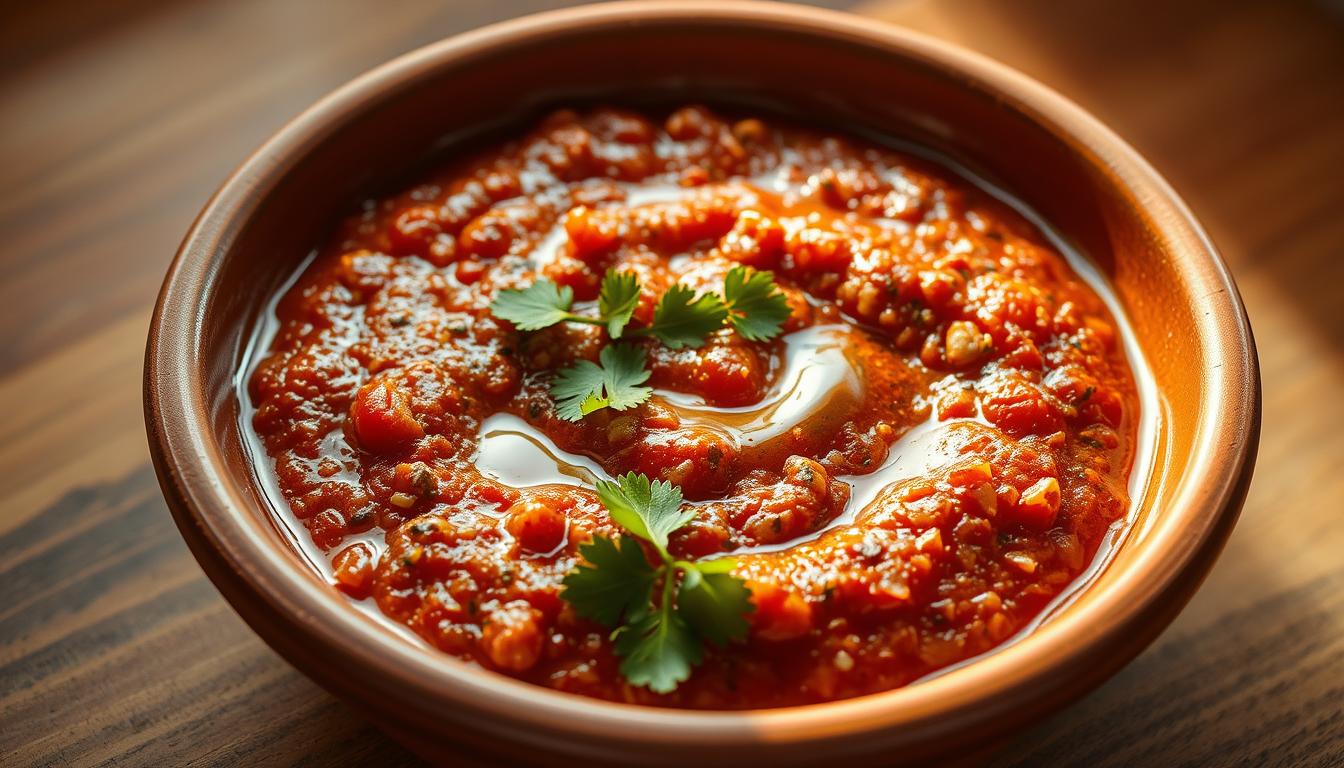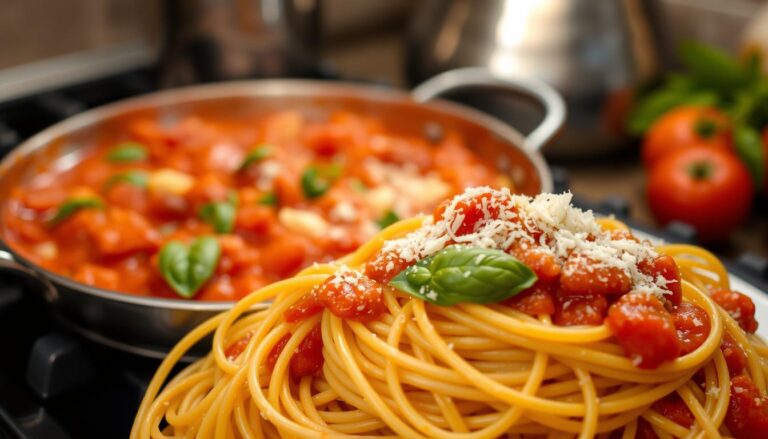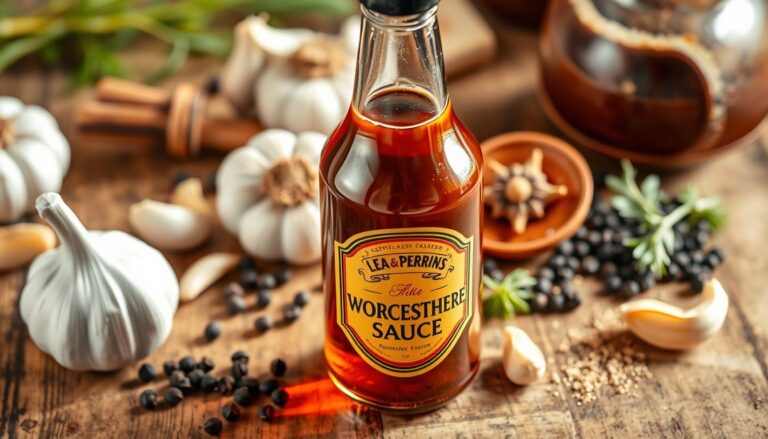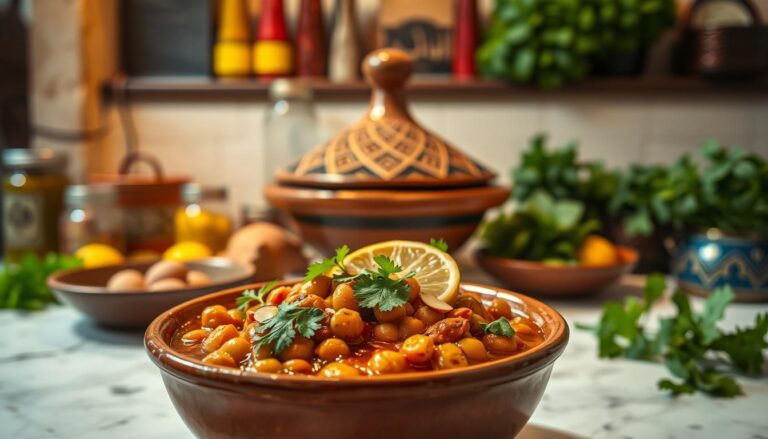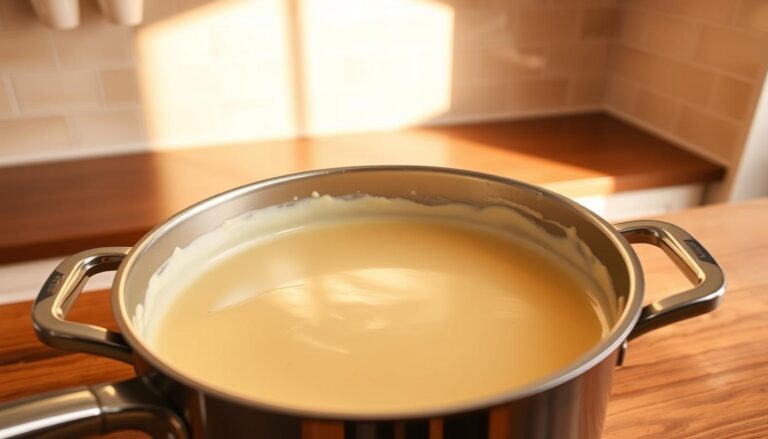Chermoula Sauce: Elevate Your Meals with This Moroccan Staple
Discover the flavors of North Africa with chermoula sauce, a versatile and aromatic Moroccan sauce that can elevate various dishes.
This traditional condiment is a staple in North African cuisine, made with fresh herbs, garlic, and lemon juice. It adds a burst of flavor to grilled meats, vegetables, and bread.
Key Takeaways
- Learn how to make authentic chermoula sauce at home.
- Explore the various uses of chermoula sauce in different cuisines.
- Understand the significance of chermoula sauce in North African culture.
- Get tips on storing and preserving chermoula sauce.
- Discover the health benefits of incorporating chermoula sauce into your meals.
What is Chermoula Sauce?
With its rich blend of herbs and spices, chermoula sauce is a versatile addition to many dishes. This traditional Moroccan condiment has gained popularity across North Africa and beyond, known for its vibrant flavor and aromatic properties.
The Flavor Profile of Chermoula
The flavor profile of chermoula is characterized by its fresh, herbaceous taste, primarily from cilantro and parsley, complemented by the warmth of spices like cumin, coriander, and paprika. The addition of garlic and lemon juice gives it a tangy and aromatic quality, making it a dynamic condiment for various culinary applications.
Regional Variations Across North Africa
Chermoula sauce exhibits regional variations across North Africa, reflecting local tastes and ingredient availability. The following table highlights some of these variations:
| Country | Variation | Key Ingredients |
|---|---|---|
| Morocco | Classic Chermoula | Cilantro, parsley, cumin, coriander, garlic, lemon |
| Tunisia | Spicy Chermoula | Addition of hot peppers or harissa |
| Algeria | Saffron and Turmeric Chermoula | Saffron threads and turmeric powder for added depth |
These regional variations demonstrate the adaptability and richness of chermoula sauce, making it a fascinating condiment to explore in various culinary contexts.
The Rich History and Cultural Significance of Chermoula
Morocco is the birthplace of chermoula sauce, a condiment that has traveled far and wide, gaining global popularity. Chermoula sauce has a rich history that is deeply intertwined with the cultural and culinary traditions of North Africa.
Moroccan Origins
Chermoula originated in Morocco, where it has been a staple condiment for centuries. The sauce is deeply rooted in Moroccan cuisine, often used to flavor grilled meats, fish, and vegetables. Its preparation involves a mix of fresh herbs, garlic, lemon juice, and olive oil, creating a flavor profile that is both aromatic and tangy.
Spread Throughout North Africa
From Morocco, chermoula sauce spread to other parts of North Africa, including Tunisia and Algeria. Each region adapted the recipe to its own taste, incorporating local ingredients and spices. This regional variation enriched the sauce’s flavor profile, making it a diverse and dynamic condiment across the region.
Modern Global Popularity
Today, chermoula sauce enjoys global popularity, appreciated for its fresh flavor and versatility. It is used not only in traditional North African dishes but also as a marinade, condiment, and finishing sauce in modern cuisine worldwide. The global culinary scene has embraced chermoula for its ability to add depth and complexity to a wide range of dishes.
Essential Ingredients for Authentic Chermoula Sauce
To make authentic Chermoula sauce, you’ll need to gather a few essential ingredients that provide its characteristic flavor and aroma. The beauty of Chermoula lies in its simplicity, using fresh herbs, spices, and aromatics that are readily available in most kitchens.
Fresh Herbs: Cilantro and Parsley
Fresh herbs are the backbone of Chermoula sauce, with cilantro and parsley being the most commonly used. These herbs not only add a burst of freshness but also contribute to the sauce’s vibrant green color. Cilantro brings a slightly citrusy flavor, while parsley adds a hint of bitterness to balance out the taste.
Spices: Cumin, Coriander, and Paprika
The spice blend in Chermoula sauce is what gives it depth and warmth. Cumin, coriander, and paprika are the key spices used. Cumin adds an earthy flavor, coriander provides a slightly sweet and citrusy note, and paprika contributes a smoky undertone. Together, they create a complex and aromatic spice profile.
Aromatics: Garlic and Lemon
Aromatics play a crucial role in enhancing the flavor of Chermoula sauce. Garlic is used to add a pungency that complements the freshness of the herbs, while lemon juice provides a tangy and refreshing contrast. The combination of garlic and lemon juice helps to balance out the richness of the herbs and spices, creating a well-rounded flavor profile.
How to Make Traditional Chermoula Sauce at Home
Creating your own chermoula sauce from scratch allows you to control the ingredients and tailor the flavor to your liking. With a few simple ingredients and some basic kitchen equipment, you can make this traditional Moroccan condiment in the comfort of your own home.
Step-by-Step Basic Recipe
To make traditional chermoula sauce, start by gathering the necessary ingredients: fresh parsley, cilantro, garlic, lemon juice, olive oil, cumin, coriander, salt, and paprika. Begin by finely chopping the parsley and cilantro. In a blender or food processor, combine the chopped herbs, garlic, lemon juice, and spices. Blend until you achieve a smooth consistency, then slowly add the olive oil while continuing to blend until fully incorporated.
Taste and adjust the seasoning as needed. For a more refined texture, you can strain the sauce through a fine-mesh sieve to remove any solids.
Equipment Needed
The basic equipment required includes a sharp knife for chopping the herbs, a cutting board, a blender or food processor, a measuring cup, and a spoon for tasting and adjusting the seasoning. A fine-mesh sieve is optional for a smoother texture.
Texture Variations: Paste vs. Sauce
Chermoula sauce can range from a thick paste to a thinner sauce, depending on your preference and intended use. For a paste, use less lemon juice or olive oil. For a sauce, add more of these liquids. The versatility in texture makes chermoula suitable for various applications, from marinades to dips.
Tips for Perfect Consistency
To achieve the perfect consistency, adjust the amount of olive oil and lemon juice. If the sauce is too thick, add a bit more oil or lemon juice. If it’s too thin, you can add more herbs or spices to thicken it. The key is to taste as you go and adjust accordingly.
Popular Regional Variations of Chermoula Sauce
As we explore the regional variations of chermoula sauce, we discover a rich tapestry of flavors that reflect the diverse culinary traditions of North Africa.
Spicy Moroccan Chermoula with Harissa
In Morocco, chermoula sauce is often made with harissa, adding a spicy kick that complements the freshness of cilantro and parsley. This variation is perfect for those who enjoy a bit of heat in their dishes. The spicy chermoula is commonly used as a marinade for grilled meats and vegetables.
Tunisian Chermoula with Preserved Lemon
Tunisian cuisine incorporates preserved lemon into its chermoula, giving it a tangy and salty flavor. This unique twist enhances the sauce’s complexity and pairs well with fish and seafood dishes. The preserved lemon adds a distinctive taste that sets Tunisian chermoula apart.
Algerian Saffron and Turmeric Variations
Algerian variations of chermoula often include saffron and turmeric, which add a vibrant color and a subtle earthy flavor. These ingredients not only enhance the visual appeal of the sauce but also contribute to its aromatic profile. The use of saffron and turmeric reflects the rich spice trade history of the region.
| Region | Key Ingredients | Characteristics |
|---|---|---|
| Moroccan | Harissa, cilantro, parsley | Spicy, fresh |
| Tunisian | Preserved lemon, garlic | Tangy, salty |
| Algerian | Saffron, turmeric | Earthy, aromatic |
Chermoula Sauce as a Versatile Marinade
Chermoula sauce doubles as an excellent marinade, capable of transforming ordinary meals into extraordinary culinary experiences. Its rich blend of herbs, spices, and aromatics makes it an ideal candidate for marinating a wide range of foods.
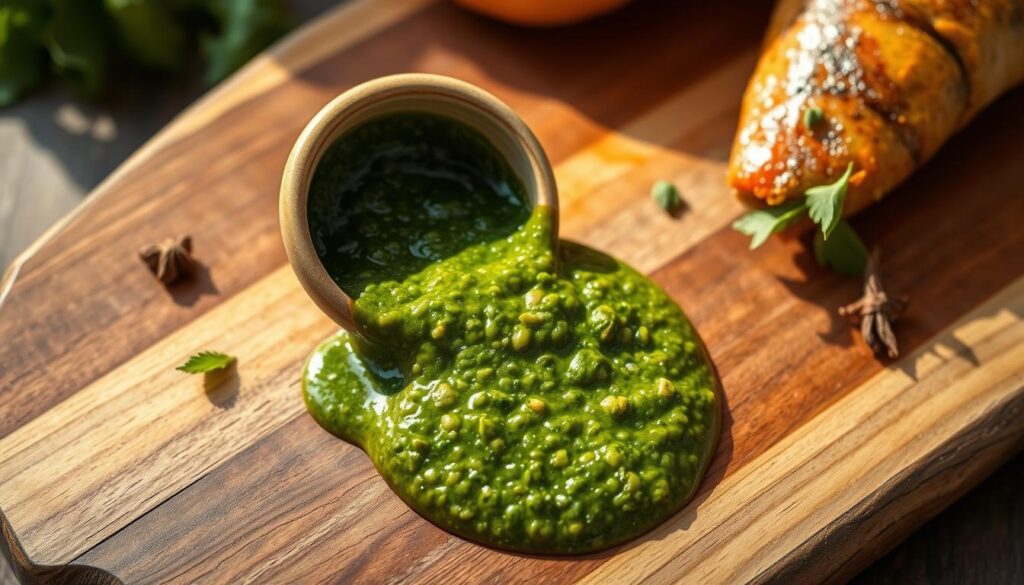
The versatility of chermoula sauce as a marinade lies in its ability to enhance the natural flavors of various ingredients without overpowering them. Whether you’re cooking fish, meat, or vegetables, chermoula sauce can elevate your dishes to new heights.
For Fish and Seafood Dishes
When it comes to fish and seafood, chermoula sauce is a game-changer. It adds a bright, citrusy flavor that complements the delicate taste of fish without overpowering it. Try marinating salmon or tilapia in chermoula sauce before grilling or baking for a dish that’s both healthy and flavorful.
- Salmon fillets marinated in chermoula sauce make for a delicious grilled dinner.
- Shrimp skewers coated with chermoula sauce are perfect for a summer barbecue.
For Poultry and Red Meats
Chermoula sauce is equally effective as a marinade for poultry and red meats. The combination of garlic, cumin, and coriander infuses chicken, beef, or lamb with a deep, complex flavor profile. For a memorable barbecue, marinate chicken thighs or beef skewers in chermoula sauce for several hours before grilling.
Some popular options include:
- Chicken thighs marinated in chermoula sauce and grilled to perfection.
- Beef or lamb skewers coated with chermoula sauce for a flavorful barbecue.
For Vegetables and Plant-Based Proteins
Vegetarians and vegans can also benefit from using chermoula sauce as a marinade. It pairs well with a variety of vegetables, such as bell peppers, zucchini, and eggplant, adding a burst of flavor when grilled or roasted. Tofu and tempeh also absorb the flavors of chermoula sauce beautifully, making them perfect for plant-based meals.
Try marinating:
- Portobello mushrooms in chermoula sauce for a hearty vegetarian dish.
- Tofu or tempeh in chermoula sauce for a flavorful plant-based protein source.
Using Chermoula as a Condiment and Finishing Sauce
Beyond its traditional uses, chermoula sauce serves as an excellent condiment and finishing touch for a variety of dishes. Its rich flavor profile makes it an ideal addition to many meals.
Serving with Grilled and Roasted Foods
Chermoula sauce pairs exceptionally well with grilled and roasted foods. It adds a burst of fresh, herbaceous flavor to grilled meats, vegetables, and seafood. Try drizzling it over roasted vegetables or using it as a dip for grilled halloumi.
Adding to Soups, Stews, and Tagines
Chermoula can also be used to add depth and complexity to soups, stews, and tagines. Stir it in towards the end of cooking to preserve its vibrant flavors. This technique works particularly well in hearty stews and slow-cooked tagines.
As a Dip, Spread, or Salad Dressing
The versatility of chermoula sauce extends to its use as a dip, spread, or even a salad dressing. Use it as a dip for crudités or pita bread, spread it on sandwiches for added flavor, or whisk it with olive oil to create a tasty salad dressing.
| Usage | Description | Recommended Pairing |
|---|---|---|
| Grilled/Roasted Foods | Drizzle or serve on the side | Grilled meats, roasted vegetables |
| Soups/Stews/Tagines | Stir in towards the end | Hearty stews, slow-cooked tagines |
| Dip/Spread/Salad Dressing | Serve as is or whisk with olive oil | Crudités, pita bread, salads |
By incorporating chermoula sauce into your culinary repertoire, you can add a touch of Moroccan flavor to a wide range of dishes, from traditional tagines to modern fusion cuisine.
Must-Try Chermoula-Inspired Recipes
From marinades to finishing sauces, chermoula can be used in a multitude of creative ways to enhance your meals. This versatile sauce is a staple in North African cuisine, and its uses extend far beyond traditional dishes. Here, we’ll explore some delicious and innovative chermoula-inspired recipes to try at home.
Chermoula-Marinated Grilled Fish
Grilled fish is a classic dish that pairs perfectly with the vibrant flavors of chermoula sauce. To make chermoula-marinated grilled fish, simply marinate your favorite fish in a mixture of chermoula sauce, olive oil, and lemon juice for at least 30 minutes before grilling. The result is a dish that’s both flavorful and healthy.
Roasted Vegetables with Chermoula
Roasted vegetables are a great canvas for the bold flavors of chermoula sauce. Toss your favorite vegetables (such as Brussels sprouts or carrots) with chermoula sauce, olive oil, and salt before roasting in the oven. The chermoula adds a rich, herby flavor that complements the natural sweetness of the vegetables.
Chermoula Chicken Tagine
Tagine is a traditional Moroccan stew named after the earthenware pot in which it’s cooked. To make a chermoula chicken tagine, marinate chicken in chermoula sauce and then slow-cook it with onions, garlic, and preserved lemons. The result is a hearty, aromatic stew that’s perfect for cold winter nights.
Chermoula Sauce with Couscous and Legumes
Couscous and legumes are a staple in North African cuisine, and chermoula sauce makes a great addition to this comforting dish. Simply cook couscous and your favorite legumes (such as chickpeas or lentils), then toss with chermoula sauce, chopped fresh herbs, and a squeeze of lemon juice. This is a quick and easy way to add flavor to a simple, nutritious meal.
Storing and Preserving Your Homemade Chermoula Sauce
Homemade chermoula sauce requires careful storage to preserve its vibrant flavor and nutritional value. Proper storage not only maintains the quality of the sauce but also ensures it remains safe to consume.
Refrigeration Guidelines and Shelf Life
After preparing your chermoula sauce, transfer it to an airtight container, such as a glass jar with a tight-fitting lid. Store it in the refrigerator at a temperature below 40°F (4°C). When stored correctly, homemade chermoula sauce can last for up to 1 week in the refrigerator. It’s essential to check the sauce regularly for any signs of spoilage.
Freezing Methods for Longer Storage
For longer storage, consider freezing your chermoula sauce. Pour the sauce into an airtight container or freezer-safe bag, leaving about 1 inch of space at the top for expansion. Label the container with the date and contents. Frozen chermoula sauce can be stored for up to 6 months. When you’re ready to use it, simply thaw the sauce in the refrigerator or at room temperature.
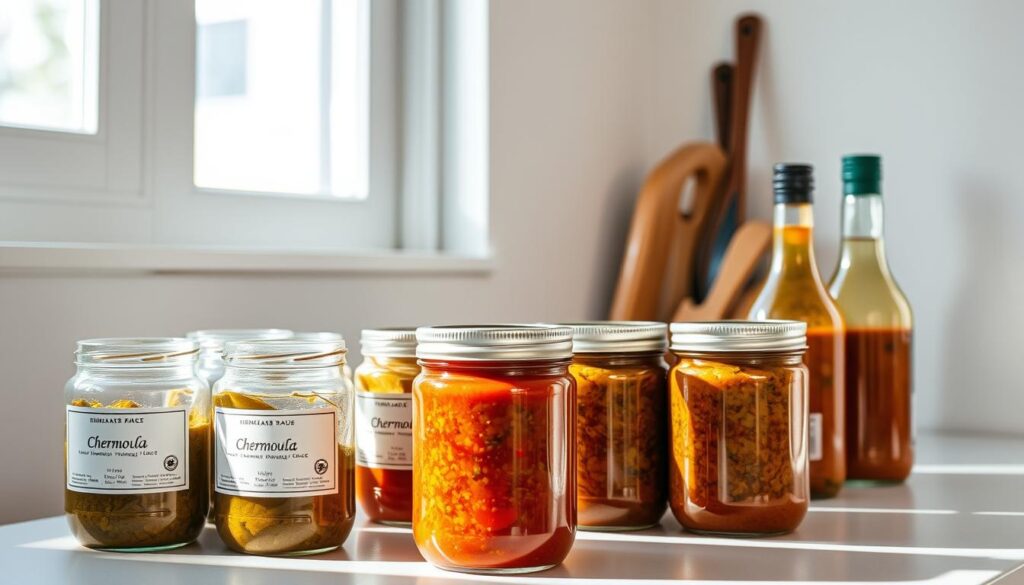
Signs of Spoilage to Watch For
Regularly inspect your stored chermoula sauce for signs of spoilage, such as an off smell, slimy texture, or mold growth. If you notice any of these signs, it’s best to err on the side of caution and discard the sauce. Always use clean utensils when handling the sauce to prevent contamination.
By following these storage guidelines, you can enjoy your homemade chermoula sauce for a longer period while maintaining its flavor and safety.
Health Benefits of Chermoula Sauce Ingredients
Chermoula sauce, a staple in North African cuisine, is also a powerhouse of nutrition. Its ingredients not only add flavor to dishes but also provide several health benefits.
Nutritional Profile and Caloric Content
Chermoula sauce is made from a blend of fresh herbs, spices, garlic, and lemon juice, making it low in calories but rich in nutrients. A serving size of chermoula sauce (approximately 2 tablespoons) contains a minimal amount of calories, around 10-20 calories, depending on the specific ingredients used. It is also rich in vitamins A and C, thanks to the presence of parsley, cilantro, and lemon juice.
Antioxidant and Anti-inflammatory Properties
The herbs and spices in chermoula sauce, such as cilantro and cumin, are known for their antioxidant properties. These compounds help protect the body from oxidative stress and can reduce inflammation. The anti-inflammatory effects are further enhanced by the presence of garlic, which contains compounds that have been shown to reduce inflammation in the body.
Digestive Benefits and Immune Support
The ingredients in chermoula sauce also offer digestive benefits. Garlic, for instance, has been used for centuries to aid digestion. Additionally, the antioxidants and vitamins in chermoula sauce can help support the immune system, protecting against common illnesses. Regular consumption of chermoula sauce can be a flavorful way to enhance your overall health.
Some key benefits of chermoula sauce include:
- Rich in antioxidants
- Anti-inflammatory properties
- Aids in digestion
- Supports immune function
- Low in calories
Incorporating chermoula sauce into your diet can be a simple and delicious way to boost your health.
Where to Find Chermoula Sauce and Specialty Ingredients
Locating chermoula sauce and its unique ingredients is easier than you think. With the growing popularity of global cuisine, many stores now carry the necessary components for this flavorful Moroccan staple.
Specialty Stores and International Markets
Specialty stores and international markets are excellent places to find chermoula sauce ingredients. Stores that specialize in North African or Middle Eastern products often carry fresh herbs like cilantro and parsley, as well as spices such as cumin and coriander. International markets may also stock preserved lemons, a key ingredient in some chermoula variations.
Online Sources and Brands to Try
For those without access to specialty stores, online sources are a convenient alternative. Many online retailers offer a wide range of chermoula sauce ingredients, including hard-to-find items. Brands like Zabar’s and Kalustyan’s offer high-quality ingredients and prepared chermoula sauce. Online marketplaces like Amazon also feature various chermoula sauce products.
Ingredient Substitutions in a Pinch
If certain ingredients are unavailable, substitutions can be made. For example, if fresh cilantro is not available, you can use parsley or a combination of parsley and basil as a substitute. The key is to maintain the balance of fresh herbs, spices, and aromatics that give chermoula its distinctive flavor.
| Ingredient | Substitution |
|---|---|
| Fresh Cilantro | Parsley or Parsley-Basil Mix |
| Preserved Lemons | Lemon Juice with Salt |
| Cumin | Ground Coriander |
Conclusion: Why Chermoula Sauce Deserves a Place in Your Kitchen
Chermoula sauce is more than just a condiment; it’s a kitchen staple that can elevate a wide range of dishes. Its unique flavor profile, which combines the freshness of herbs like cilantro and parsley with the warmth of spices like cumin and coriander, makes it a versatile flavor enhancer for various cuisines.
Whether you’re grilling fish, roasting vegetables, or cooking a hearty tagine, chermoula sauce can add depth and complexity to your meals. Its uses are endless, from marinades and sauces to dips and salad dressings. By incorporating chermoula sauce into your culinary repertoire, you can explore the rich flavors of North African cuisine and beyond.
With its numerous health benefits, including antioxidant and anti-inflammatory properties, chermoula sauce is not only a flavorful addition but also a nutritious one. As you’ve learned, making chermoula sauce at home is straightforward, and with the right ingredients, you can enjoy this chermoula sauce all year round.
So, why not give chermoula sauce a try? Experiment with different recipes, and discover how this incredible condiment can transform your cooking. With chermoula sauce in your kitchen, you’ll be well on your way to creating delicious, memorable meals that will leave everyone wanting more.
FAQ
What is chermoula sauce?
What are the main ingredients in chermoula sauce?
Can I make chermoula sauce at home?
How do I store homemade chermoula sauce?
What are some uses for chermoula sauce?
Are there different regional variations of chermoula sauce?
Can I substitute ingredients in chermoula sauce?
Is chermoula sauce healthy?
Where can I buy chermoula sauce or its ingredients?
Can I use chermoula sauce with different types of cuisine?
for more sauce : https://www.secretofgrandma.com/category/sauce/
history of africa chermoula sauce : https://en.wikipedia.org/wiki/Chermoula

